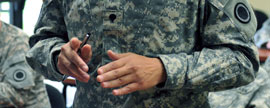You are correct that an award should not be based on an individual’s rank but on performance or achievement. You hit the nail on the head with your comment regarding responsibility. Typically individuals with more rank tend to receive higher awards because of the level and scope of their responsibilities. Based on your description of events you feel that SSG should have received the award he was recommended for. There are two options available:
- A simple conversation with leader who disapproved the award explaining that there is a perception of unfair treatment with regard to the awards process. This may be enough to resolve the issue. If it does not result in a relook for this award it may help other Soldiers in the future.
- Speak with the individual who downgraded the award and respectfully ask why the award was downgraded. The award may have been downgraded because the write up did not support the award. If during the course of the conversation the leader states it was based on rank you can then explain that is not in compliance with AR 600-8-22 3-1 c and ask for the award to be reconsidered. I would suggest having a copy of the regulation or a reference to the regulation with you. If the leader states that the write up did not justify the award ask for assistance in resubmitting the award so that the Soldier can receive the proper level of recognition.
The conversation you have with this leader needs to be calm, professional, and unemotional.
AR 600-8-22 3-1 c:
“Awards for meritorious achievement or service will not be based upon the grade of the intended recipient. Rather, the award should reflect both the individual’s level of responsibility and his or her manner of performance. The degree to which an individual’s achievement or service enhanced the readiness or effectiveness of his or her organization will be the predominant factor.”
The Writer: The comprehensive guide for writing awards contains over 130 Army award examples including combat narratives, combat citations, and awards for valor.













Comments
sgt smith
What is the requirement for a purple heart
Mark Gerecht
The Specfics regarding the purple heart can be found in AR 600-8-22
2–8. Purple Heart
a. The Purple Heart was established by General George Washington at Newburgh, New York, on 7 August 1782, during the Revolutionary War. It was reestablished by the President of the United States per War Department General Orders 3, 1932 and is currently awarded pursuant to Executive Order 11016, 25 April 1962; Executive Order 12464, 23 February 1984; Public Law 98-525, 19 October 1984 amended by Public Law 100–48, 1 June 19871; Public Law 103-160, 30 November 1993; Public Law 104-106, 10 February 1996; and Public Law 105-85, 18 November 1997.
b. The Purple Heart is awarded in the name of the President of the United States and per 10 USC 1131, effective 19 May 1998, is limited to members of the Armed Forces of the United States who, while serving under component authority in any capacity with one of the U.S. Armed Services after 5 April 1917, has been wounded or killed, or who has died or may hereafter die after being wounded—
(1) In any action against an enemy of the United States.
(2) In any action with an opposing armed force of a foreign country in which the Armed Forces of the United States are or have been engaged.
(3) While serving with friendly foreign forces engaged in an armed conflict against an opposing armed force in which the United States is not a belligerent party.
(4) As the result of an act of any such enemy of opposing Armed Forces.
(5) As the result of an act of any hostile foreign force.
(6) After 28 March 1973, as the result of an international terrorist attack against the United States or a foreign nation friendly to the United States, recognized as such an attack by the Secretary of Army, or jointly by the Secretaries of the separate armed services concerned if persons from more than one service are wounded in the attack.
(7) After 28 March 1973, as the result of military operations while serving outside the territory of the United States as part of a peacekeeping force.
(8) Members killed or wounded in action by friendly fire. In accordance with 10 USC 1129 for award of the Purple Heart, the Secretary of the Army will treat a member of the Armed Forces described in (a), below, in the same manner as a member who is killed or wounded in action as the result of an act of an enemy of the United States.
(a) A member described in this subsection is a member who is killed or wounded in action by weapon fire while directly engaged in armed conflict, other than as the result of an act of an enemy of the United States, unless (in the case of a wound) the wound is the result of willful misconduct of the member.
(b) This section applies to members of the Armed Forces who are killed or wounded on or after 7 December 1941. In the case of a member killed or wounded, as described in paragraph 2–8b above, on or after 7 December 1941 and before 30 November 1993, the Secretary of the Army will award the Purple Heart under provisions of paragraph 2–8a above in each case which is known to the Secretary before such date or for which an application is made to the Secretary in such manner as the Secretary requires.
c. While clearly an individual decoration, the Purple Heart differs from all other decorations in that an individual is not “recommended” for the decoration; rather he or she is entitled to it upon meeting specific criteria.
d. A Purple Heart is authorized for the first wound suffered under conditions indicated above, but for each subsequent award an Oak Leaf Cluster will be awarded to be worn on the medal or ribbon. Not more than one award will be made for more than one wound or injury received at the same instant or from the same missile, force, explosion, or agent.
e. A wound is defined as an injury to any part of the body from an outside force or agent sustained under one or more of the conditions listed above. A physical lesion is not required, however, the wound for which the award is made must have required treatment by medical personnel and records of medical treatment for wounds or injuries received in action must have been made a matter of official record.
f. When contemplating an award of this decoration, the key issue that commanders must take into consideration is the degree to which the enemy caused the injury. The fact that the proposed recipient was participating in direct or indirect combat operations is a necessary prerequisite, but is not sole justification for award.
g. Examples of enemy-related injuries which clearly justify award of the Purple Heart are as follows:
(1) Injury caused by enemy bullet, shrapnel, or other projectile created by enemy action.
(2) Injury caused by enemy placed mine or trap.
(3) Injury caused by enemy released chemical, biological, or nuclear agent.
(4) Injury caused by vehicle or aircraft accident resulting from enemy fire.
(5) Concussion injuries caused as a result of enemy generated explosions.
h. Examples of injuries or wounds which clearly do not justify award of the Purple Heart are as follows:
(1) Frostbite or trench foot injuries.
(2) Heat stroke.
(3) Food poisoning not caused by enemy agents.
(4) Chemical, biological, or nuclear agents not released by the enemy.
(5) Battle fatigue.
(6) Disease not directly caused by enemy agents.
(7) Accidents, to include explosive, aircraft, vehicular, and other accidental wounding not related to or caused by enemy action.
(8) Self-inflicted wounds, except when in the heat of battle and not involving gross negligence.
(9) Post traumatic stress disorders.
(10) Jump injuries not caused by enemy action.
i. It is not intended that such a strict interpretation of the requirement for the wound or injury to be caused by direct result of hostile action be taken that it would preclude the award being made to deserving personnel. Commanders must also take into consideration the circumstances surrounding an injury, even if it appears to meet the criteria. Note the following examples:
(1) In a case such as an individual injured while making a parachute landing from an aircraft that had been brought down by enemy fire; or, an individual injured as a result of a vehicle accident caused by enemy fire, the decision will be made in favor of the individual and the award will be made.
(2) Individuals injured as a result of their own negligence; for example, driving or walking through an unauthorized area known to have been mined or placed off limits or searching for or picking up unexploded munitions as war souvenirs, will not be awarded the Purple Heart as they clearly were not injured as a result of enemy action, but rather by their own negligence.
j. During wartime the senior Army commander in the combat theater can award the Purple Heart as approval authority when delegated by the Secretary of the Army. The National Personnel Records Center, 9700 Page Avenue, St. Louis, MO 63132–5100, awards the Purple Heart to any member of the Army, who during World War I, was awarded a Meritorious Service Citation Certificate signed by the Commander in Chief, American Expeditionary Forces, or who was authorized to wear wound chevrons, upon written application. Approval authority for the Purple Heart for Army personnel wounded or killed as the result of an international terrorist attack is the Secretary of the Army. All other requests for award of the Purple Heart are processed by the Commander, USAHRC (AHRC–PDO–PA). The f o l l o w i n g t y p e s o f r e q u e s t s f o r a w a r d o f t h e P u r p l e H e a r t w i l l b e f o r w a r d e d t o t h e C o m m a n d e r , U S A H R C ,
AHRC–PDO–PA, 200 Stovall Street, Alexandria, VA 22332–0471:
(1) Any member of the Army who was awarded the Purple Heart for meritorious achievement or service, as opposed to wounds received in action, between 7 December 1941 and 22 September 1943, may apply for award of an appropriate decoration instead of the Purple Heart. (2) For those who became Prisoners of War during World War II, the Korean War and before and after 25 April
1962, the Purple Heart will be awarded to individuals wounded while prisoners of foreign forces, upon submission by the individual to the Department of the U.S. Army of an affidavit that is supported by a statement from a witness, if this is possible.
(3) Any member of the U.S. Army who believes that he or she is eligible for the Purple Heart, but through unusual c i r c u m s t a n c e s n o a w a r d w a s m a d e , m a y s u b m i t a n a p p l i c a t i o n t h r o u g h m i l i t a r y c h a n n e l s , t o t h e C o m m a n d e r , USAHRC, AHRC–PDO–PA. The application will include complete documentation, to include evidence of medical treatment, pertaining to the wound.
k. The following rules apply for processing award of the Purple Heart:
(1) The statutory time limits pertaining to award of military decorations does not apply to the Purple Heart. The Purple Heart may be awarded at anytime after submission of documented proof that criteria have been met.
(2) Approved awards of the Purple Heart require the publication of permanent orders according to AR 600–8–105, citing each recipient. A DA Form 4980–10 (The Purple Heart Medal Certificate) will include the following information: The recipient’s name and grade, date wounded in action, and date certificate is signed. All Purple Heart Medal certificates will bear the signature and signature block of the Secretary of the Army on the right side. During wartime, the signature and signature block of the commander authorized to award the Purple Heart will be on the left side. All other Purple Hearts awarded will bear the signature and signature block of The Adjutant General of the Army.
(3) Each approved award of the Purple Heart must exhibit all of the following factors: wound, injury or death must have been the result of enemy or hostile act; international terrorist attack; or friendly fire (as defined in paragraph b(8) above) the wound or injury must have required treatment by medical officials; and the records of medical treatment
must have been made a matter of official Army records.
(4) Recommendations for award of the Purple Heart based on alleged international terrorist attacks must be accompanied by a written evaluation from the MACOM security and intelligence staff officer indicating that international terrorist activity was involved. Should any enclosures be classified the prescribed security measures will be followed. This requirement is in addition to the other eligibility criteria. HQ, USAHRC (AHRC–PDO–PA) will confirm the international terrorist report with the Office of the Deputy Chief of Staff, G–2 (ODCS, G-2) prior to
forwarding the Purple Heart recommendations to the Secretary of the Army for final decision.
l. The Defense of Freedom Medal, established on 4 October 2001, is the civilian equivalent to the Purple Heart awarded to U.S. military personnel. Refer to AR 672–20 for criteria and requirements for the Defense of Freedom Medal